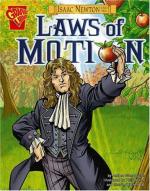|
This section contains 393 words (approx. 2 pages at 300 words per page) |
Prior to the seventeenth century, the Greek concept of motion was widely accepted. This view held that without constant force to propel it, an object's motion would cease. While such an idea was useful in understanding everyday events on earth such as the behavior of a thrown rock, it was inadequate when applied to situations on a larger scale, like the movement of planets. Why did they continue moving year after year without ever being touched? Exasperated philosophers and religious leaders invoked supernatural causes such as the motive power of angels to explain how celestial motion was sustained.
Isaac Beeckman and Galileo Galilei took the first steps toward understanding motion scientifically when they suggested that bodies did not seek a state of rest but rather maintained their current state (a state of rest or motion) unless affected by an outside force. Not long after, Isaac Newton put this theory into a mathematical framework in the form of three laws which could easily be used to predict interactions between objects.
Newton's laws, published in his Principia in 1687, were as follows: first, any body, unless it is affected by an outside force, remains at rest or continues at a constant speed in a straight line. Second, when acted upon by a force, a body will accelerate in proportion to the force applied, in the direction the force is applied. Given the same force, acceleration will be inversely proportional to the mass of the body. Finally, every force applied to an object is accompanied by an equal and opposite force on another body. For instance, when a bullet is fired from a gun, the gun recoils in the opposite direction.
Newton combined the laws of motion with his law of gravity, also defined in the Principia, to explain the behavior of orbiting planets. The orbital motion of a planet, he reasoned, was simply a combination of motion in a straight line with the gravitational pull of the sun. In other words, a planet's gravitational acceleration toward the sun was exactly equal to its forward motion, so it kept spinning in a circle indefinitely, "falling" and escaping equally. Indeed, Newton's potent combination of the two sets of laws applied equally to bodies on earth as to those in space, elegantly and rationally predicting any motion to very close tolerances.
|
This section contains 393 words (approx. 2 pages at 300 words per page) |


